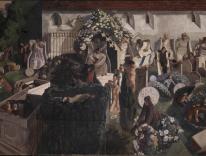The rise(s) and fall(s) of neoconservatism is an oft-told tale. So why do we need to hear it again? Three decades ago, Peter Steinfels offered a fair-minded but critical diagnosis of the neoconservative persuasion (The Neoconservatives, 1979). At the end of his narrative, Steinfels observed that neoconservatism had begun as an “antibody on the Left”—a corrective to the excesses of the 1960s rather than an abandonment of liberalism. During the ’70s, however, it had become an “independent force” that might end by destroying what it had sought to preserve. Less than a year after the publication of Steinfels’s book, many leading neoconservatives endorsed Ronald Reagan and effectively, if not officially, severed their links with the Democratic Party.
It is no criticism of Steinfels to observe that he did not anticipate the cause of this rupture. Most of his account is devoted to domestic policy and broader cultural issues. But neoconservatives did not then (and do not to this day) repudiate the New Deal or espouse limited government. It was dismay over Jimmy Carter’s foreign policy, not welfare and affirmative action, that led them into Reagan’s camp.
Jacob Heilbrunn’s new book rectifies the balance. While he gestures toward neoconservatives’ “trenchant social and political critique of the Great Society,” he focuses on their “vigorous, Israel-centered anti-Communist foreign policy.” In itself, this is not exactly news; both the movement’s admirers and detractors have long noted these features of its international views. And after five years of American involvement in Iraq, it is hardly surprising to suggest that neoconservatism has exerted more influence on the Bush administration’s foreign than domestic decisions.
Heilbrunn does break new ground, however, in exploring neoconservatism’s origins. It emerged, he argues, out of the experiences of ambitious young Jews born to immigrant parents in the second and third decades of the twentieth century. He states his thesis bluntly: “neoconservatism is as much a reflection of Jewish immigrant social resentments and status anxiety as a legitimate movement of ideas. Indeed, however much [the neocons] may deny it, neoconservatism is in a decisive respect a Jewish phenomenon, reflecting a subset of Jewish concerns.”
Three elements of this subset stand out in high relief. First, the young men (and a few women) who became neoconservatives were “exquisitely attuned to the social exclusion and WASP snobbery” that their parents had experienced. This accounts, Heilbrunn suggests, for the antipathy they feel for institutions—such as the State Department, the CIA, major foundations, and the Ivy League—that they view as dominated by the residual WASP elite.
Second, they were haunted by the failure of liberalism in the 1930s—by the destruction of the Weimar Republic and by the West’s failure to stand up to totalitarianism. As a result, Heilbrunn asserts, neoconservatives “see new Munichs everywhere and anywhere.”
Third, most leading neoconservatives began as followers of Leon Trotsky—that is, as an embattled minority on the Marxist Left. Although their views changed dramatically in ensuing decades, the spirit of opposition and of fierce, uncompromising intellectual warfare they developed during those early years continued to characterize their stance. Even when they ceased to be radical in substance, they remained radical in style and temperament. In this respect, argues Heilbrunn, neoconservatism is a secularized version of the Jewish prophetic tradition, and neoconservatives are happiest when they can think of themselves as lonely voices of morality going up against corrupt and flaccid elites.
Heilbrunn is at his best in reconstructing the world of the 1930s out of which neoconservatism evolved—the world of Max Shachtman and the Partisan Review. It is startling to learn how long the young Trotskyites remained equally scornful of Stalinism and capitalism, how long they failed to make “any meaningful distinctions between Roosevelt and Stalin, Churchill and Hitler.” In 1943, Shachtman declared that “England, France, and Poland were not fighting for democracy or against fascism, but for imperialist gain and power;...in this decisive respect, they differed not at all from the equally predatory Axis.” As late as 1943, Irving Kristol was attacking Sidney Hook for supporting World War II.
The other great historical pivot point was, of course, the 1960s. Heilbrunn suggests that the older generation of neoconservatives “panicked” as radicals attacked Israel, the universities, and bourgeois morality. What they saw as the spinelessness of the WASP patriciate—Yale’s Kingman Brewster, Cornell’s James Perkins, the Ford Foundation’s McGeorge Bundy—evoked their contempt. Meanwhile, the emerging younger generation saw ’60s radicalism as an opportunity to reenact their parents’ fearless anti-Stalinism.
Unlike Steinfels, who examined neoconservatism from the outside as an intellectual and political phenomenon, Heilbrunn writes as a former member of the movement. The result is an uneasy blend of history and memoir that scants serious analysis of neoconservatives’ actual views or of the consequences of their policies and focuses instead on their presumed motives. For all I know, there may be some truth to his assertions. But it is impossible to tell, because he provides neither sources nor evidence to support them.
For example, Heilbrunn describes former Deputy Defense Secretary Paul Wolfowitz as “racked with guilt at the abandonment of the Kurds and Shiites at the end of the Gulf War, and enraged by Colin Powell’s failure to do anything about it.” Perhaps, but there is no footnote to either an interview with Wolfowitz himself or with anyone else in a position to know. (I can find no evidence in the book that Heilbrunn ever talked with Wolfowitz.)
Another example: In Heilbrunn’s account, neoconservatives “started out as intellectuals who were attracted to power. Soon enough, however, the prospect of access to the high and mighty became an end in itself.” As a result, he alleges, they sacrificed their intellectual integrity in an effort to justify the worst excesses of conservatism. Again, there may be some truth to this; it would not be the first time that intellectuals succumbed to this temptation. But it is a charge for which Heilbrunn offers no support, and it is easy to find evidence pointing in a different direction. For example, the Weekly Standard was harshly critical of the Bush administration’s China policy during the spring and summer of 2001, and I distinctly remember thinking that its editor Bill Kristol would not be dining in the White House mess anytime soon.
The problem with this book goes deeper than inadequate sourcing. By treating neoconservatism as a sociological phenomenon and as a kind of psychological deformation, Heilbrunn engages in deflationary reductionism. He does not really take neoconservatives seriously as political actors offering arguments and making choices. In the end, despite his vivid characterizations and fluid prose, he contributes little to our assessment of what is most significant about the neoconservative movement—its impact on our public policy and public life.
Related: Melinda Henneberger reviews Damon Linker’s The Theocons

